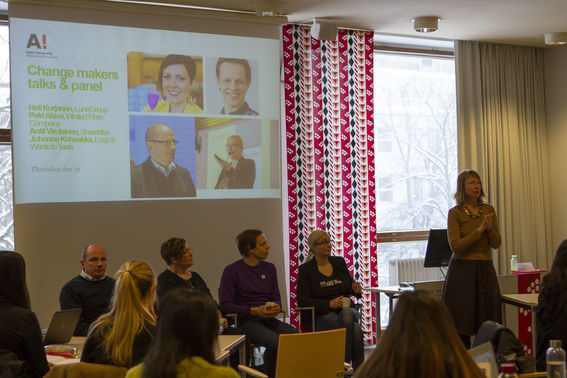How to Change the World: Innovating toward Sustainability
How to Change the World: Innovating toward Sustainability (21E10000), is an elective course in the Creative Sustainability program and is led by Prof. Minna Halme from Aalto School of Business. The course dives into ‘wicked’ sustainability challenges such as climate change, depletion of natural resources and poverty and uses them as a starting point for innovation of new forms of economic activity, business models, and organisational forms.

During the session photographed, students heard from four change making entrepreneurs who work with sustainability challenges in diverse sectors. The speakers included: Heli Kurjanen, owner and founder of LuneGroup, one of the first producers of menstrual cups made from medical silicone in Finland, Petri Alava, CEO of Infinited Fibre Company, a technology firm that allows textile waste to be used multiple times while preserving 100% of the quality, Antti Virolainen, Co-founder of Sharetribe a web-based platform which “makes it easy for anyone to create and manage their own peer-to-peer marketplace” and finally Johanna Kohvakka, Loop, a restaurant using high quality ingredients which would other wise would be thrown away and Waste to Taste, an NGO committed to reducing food waste. The session was lively and inspiring with the opportunity for students to pose questions to the entrepreneurs during a panel discussion.
"What I liked the most was the talks from the guest speakers and the reading corner. It was really interesting to have sustainable entrepreneurs in class explaining their businesses and missions. Antti Virolainen, co-founder of Sharetribe, told us about how once their platform became profitable they decided to adjust their business model so that it will focus more on the purpose: their social mission of democratizing the sharing economy, and less on the profits, as in their view they are means not end-goals. They decided then to transition to a model called steward-ownership, that allows them to make decisions focused on their customers needs, such as ensuring that the platform will always be available for them. This is something I found very inspiring, as stories of companies that decide to put a limit on their revenues are not heard everyday." Tania, CS Design Student.
At the end of the 7 week course student groups pitched their own business proposals to address vast range of challenges with realistic and plausible strategies.
More information: Mycourses | Weboodi
Photographs: Flickr






